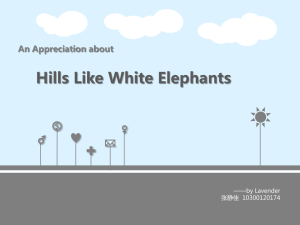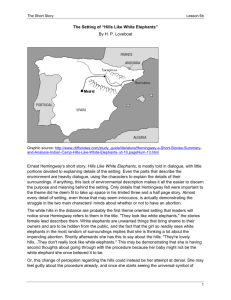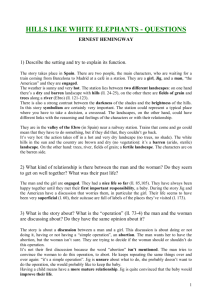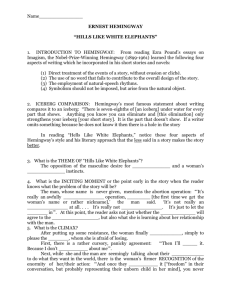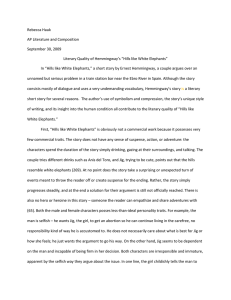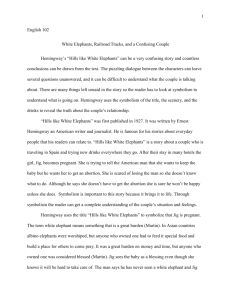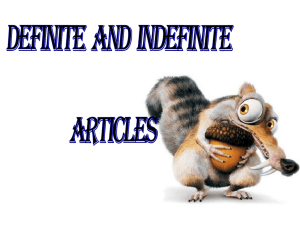Hills Like White Elephants - Paintsville Independent Schools
advertisement
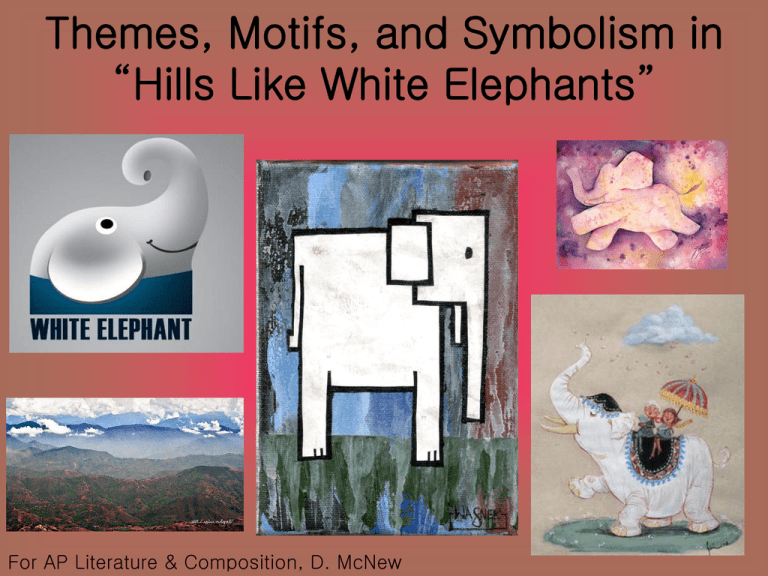
Themes, Motifs, and Symbolism in “Hills Like White Elephants” For AP Literature & Composition, D. McNew This short story is about a couple with a major conflict – the girl is pregnant and does not want an abortion – her boyfriend appears to want her to get an abortion. “Hills Like White Elephants” was written by Ernest Hemingway and was published in 1927 in a book titled “Men Without Women.” Over time, since its publication, people have read and analyzed this seemingly simple piece of fiction and have formed various opinions on the themes, motifs, and symbolism throughout. I will be presenting some of them here. THEME – the main thought or central idea expressed by a work One theme is Communication including • A conflict between the couple • Their inability to communicate effectively • The girl’s dependence upon the man Another theme...Selfishness and Manipulation “Well, let’s try and have a fine time.” “We’ll be fine afterwards. Just like we were before.” “I think it’s the best thing to do.” “I love you now. You know I love you.” “It’s really an awfully simple operation, Jig. It’s not really an operation at all.” “That’s the only thing that bothers us. It’s the only thing that’s made us unhappy.” “I know you wouldn’t mind it, Jig. It’s really not anything. It’s just to let the air in”” “I won’t worry about that because it’s perfectly simple.” “I don’t care anything about it.” “You don’t have to be afraid. I’ve known lots of people that have done it.” “I’ll go with you and I’ll stay with you all the time. They just let the air in and then it’s all perfectly natural.” “Well, if you don’t want to you don’t have to. I wouldn’t have you do it if you didn’t want to. But I know it’s perfectly simple.” “But I don’t want anybody but you. I don’t want anyone else. And I know it’s perfectly simple.” A final theme... Choices • Confronting and accepting the future OR • Evasion of responsibility MOTIF – Something that recurs throughout the piece to develop the theme. This could be a reference, an incident, or an activity. Alcohol is one motif There is drinking throughout the story • First they order two glasses of beer • Then the girl wants to try Anis del Toro • They order a second round of beers • Then they order a third round of beers • After moving the luggage, the man stops in the bar room and has another drink In trying to avoid conversation and the issue at hand, the couple fills their time with alcoholic drinks. At the end of the story they each drink alone He sits at the bar and drinks an Anis She is at the table finishing her beer from the third round A second motif The man’s over-simplification of the “operation”. Using this euphemism, rather than the harsh word “abortion”, is one way he minimizes this choice. His continuing statements stress how “perfectly simple” this process can be and also imply his strong opinion that she should just “do it”. SYMBOLISM – the use of words, places, characters, or objects that mean something beyond what they are on a literal level. A symbol is a word or object that stands for another word, object, or idea. The title actually contains three different symbols including hills, the color white, and the white elephant Hills the rounded enlargement of the girl’s stomach with a baby The Color White Symbolizes the innocence and purity of her unborn child White Elephant Symbolizes uselessness or being unwanted A white elephant sale, for example, is a type of yard sale or bargain-bin sale. At these sales, stuff that is unwanted is sold. This reference could imply that the unborn baby is useless or unwanted. White Elephant Symbolic of a valuable possession which the owner can not dispose of According to Asian legends, the possession of a white elephant was regarded as both a blessing and a curse. It was good because the animal was sacred and was considered to be a high-level gift. It was bad because the animal could not be used as a labor animal and would be expensive to own and maintain. White Elephant Symbolizes avoidance of a difficult topic (“an elephant in the room”) The phrase “an elephant in the room” is a euphemism for a topic painfully obvious that no one wants to discuss – it refers to a question, problem, or issue that is obvious but is being ignored. White Elephant strength and fertility According to tradition, Buddha’s mother had a dream about a white elephant that brought her a lotus flower. The following day she gave birth to her son. Jig (Nickname of the girl) A jig is a device used in wood working. Some have suggested that her name is symbolic because the man thinks of her as a tool – an object – rather than a person with emotions and feelings about her unborn child. A jig is also a traditional Irish dance. This nickname can show, in a subtle way, that the girl and man dance around each other and around the problem that exists without saying anything important or coming to any clear decision. Bamboo Curtains boundaries the couple is facing at this point in their life OR the separation that exists between the couple Anis del Toro This new drink that tastes like licorice can represent the innocence of Jig, since she has never heard of this drink before. This powerful liquor can symbolize the excitement that her American boyfriend has to offer to Jig, but the drink fails to deliver. Railroad Tracks These tracks are the dividing line between the green, fertile land, and the brown, dry land, representing the division that exists between the couple. These are tracks that run side-by-side, yet never meet, and could represent the relationship between Jig and her boyfriend – being together – yet never coming together. Train Station Symbolic of the point where a decision must be made, as it is the midpoint between their journeys Green Side of Station (Lush, fertile, vibrant green landscape) fertility – the growing baby – a new life – a new beginning Barren Side of Station (Brown and dry landscape) Death – the abortion – the end of life Ebro River Represents life and vitality Symbolic of the passage of time Baggage the past Hotel Labels on Baggage all of the places the couple has traveled to the man’s spirited and unrestricted lifestyle, which he will have to give up if he needs to settle down and raise a child “Hills Like White Elephants” is similar to many of Hemingway’s other short stories. He uses straightforward writing, simple prose, and skeletal sentences. Hemingway knows how to trim language and has been said to “get the most from the least.” He leaves information out of this story intentionally. This allows the readers to fill in the blanks and come to their own conclusion. Hemingway uses a style that analysts call the “Iceberg Theory.” This is very evident in “Hills Like White Elephants.” His hard facts float above the water but most of the supporting structure, filled with symbolism, operates underwater. BIBLIOGRAPHY “Elephant in the Room.” Wikipedia, The Free Encyclopedia. http://en.wikipedia.org/wiki/elephant_in_the_room. (4/6/10). Hemingway, Ernest. “Hills Like White Elephants.” Moonstar.com. http://www.moonstar.com/~acpjr/Blackboard/Common/Stories/WhiteElephants.html. (3/31/10). “Hills Like White Elephants.” Wikipedia, The Free Encyclopedia. http://en.wikipedia.org/wiki/hills_like_white_elephants. (3/31/10). “Hills Like White Elephants: A Study Guide.” Cummings Study Guide. http://www.cummingsstudyguides.net/Guides4/Hills.html. (4/1/10). “Hills Like White Elephants Symbolism, Imagery & Allegory.” Shmoop Beta. http://www.shmoop.com/hills-like-white-elephants/symbolism-imagery.html. (4/1/10). “Hills Like White Elephants – Literary Analysis.” Virginia Community College Systems Literature Website. http://www.gummyprint.com/blog/hills-like-white-elephants-literary-analysis/. (4/1/10). “Hills Like White Elephants: Themes, Motifs, and Symbols.” SparkNotes. http://www.sparknotes.com/short-stories/hills-like-white-elephants/themes.html. (4/1/10). “White Elephant.” Wikipedia, The Free Encyclopedia. http://en.wikipedia.org/wiki/white_elephant. (4/6/10).
